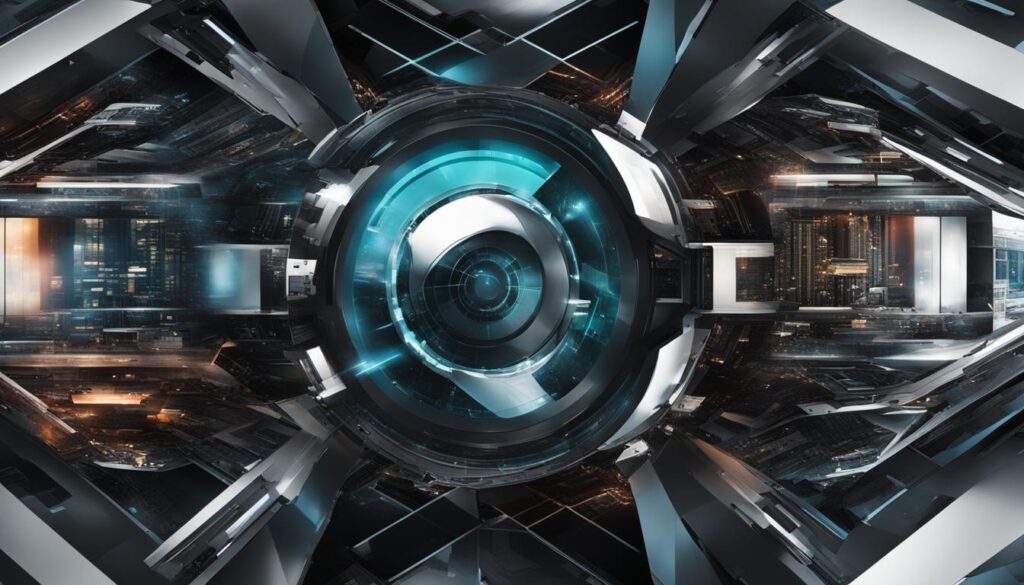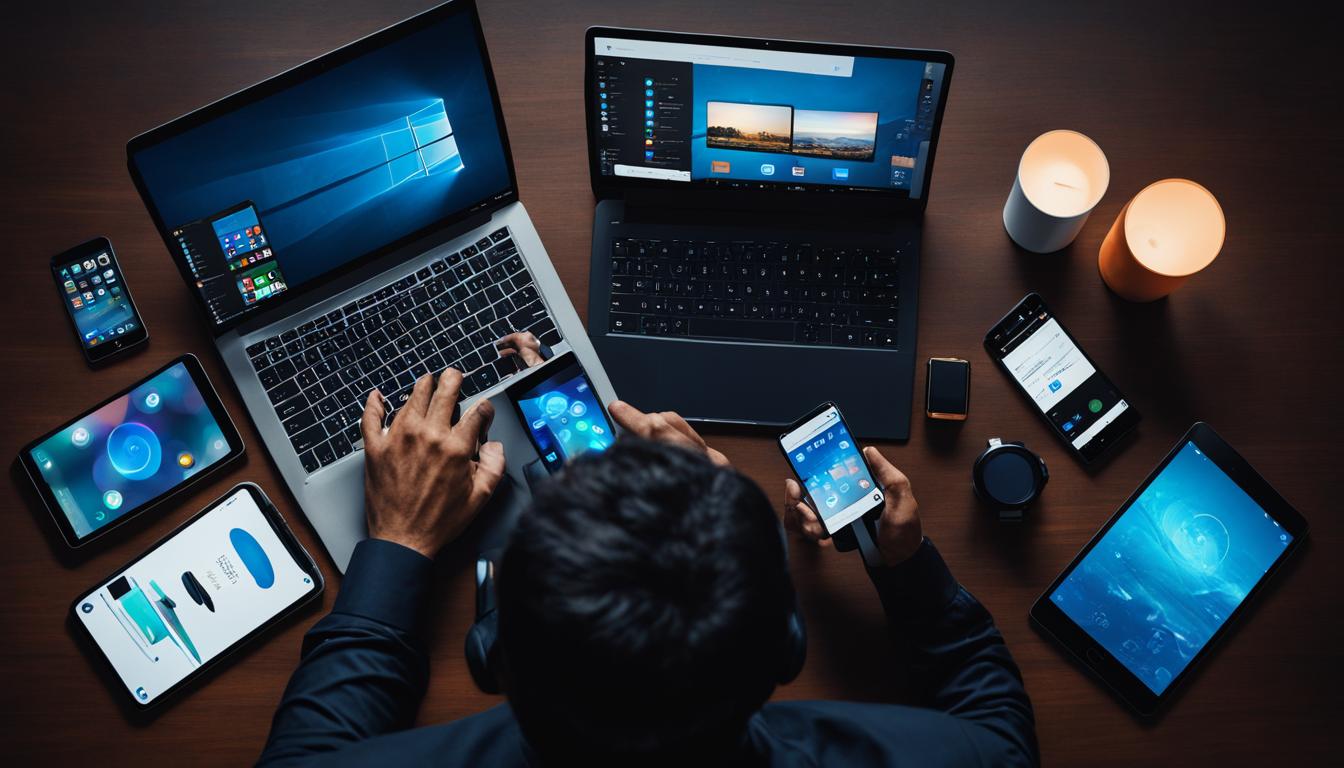Welcome to our article on the consumerization of information technology (IT). In today’s rapidly evolving digital landscape, the consumerization of IT is reshaping the way we work and interact with technology. This article will explore the definition of consumerization of IT and its impact on the corporate world.
Contents
- 1 The Impact and Benefits of Consumerization of IT
- 2 The Challenges of Consumerization of IT
- 3 BYOD Policy and Products
- 4 Examples of Consumerization of IT in the Workplace
- 5 The Connection between Disruptive Innovation and Consumerization of IT
- 6 Conclusion
- 7 FAQ
- 7.1 What is the consumerization of IT?
- 7.2 What are the benefits of the consumerization of IT?
- 7.3 What are the challenges of the consumerization of IT?
- 7.4 What is a BYOD policy?
- 7.5 What are some examples of consumerization of IT in the workplace?
- 7.6 What does the future of consumerization of IT look like?
- 7.7 What is the connection between disruptive innovation and consumerization of IT?
- 7.8 How can I understand consumerization of information technology?
- 8 Source Links
Key Takeaways:
- The consumerization of IT refers to the integration of personal technology devices and applications into the workplace.
- This trend has been fueled by the popularity of consumer tech devices like smartphones and tablets.
- It has resulted in increased productivity, convenience, and accessibility for employees.
- However, it also presents challenges such as increased costs and the need for enhanced security and governance controls.
- The future of consumerization of IT will involve managing costs, improving security, and maintaining work-life balance.
The Impact and Benefits of Consumerization of IT
The consumerization of IT has revolutionized the corporate world, bringing about numerous benefits and driving significant changes. One of the primary impacts of consumerization is the ability for employees to utilize their own personal devices for work purposes. This shift has resulted in increased productivity and convenience, as employees can seamlessly transition between personal and professional tasks on a device they are already familiar with.
By leveraging consumer technology, organizations have also witnessed cost savings. The adoption of personal devices as work tools has eliminated the need for extensive training, as employees are already well-versed in the operation of their devices. This not only saves time but also minimizes the expenses associated with traditional training programs.
Furthermore, consumer tech offers employees easy access to business applications, allowing them to leverage innovative tools and stay ahead in a rapidly evolving market. The consumer tech industry is known for its fast-paced innovation, ensuring that employees have access to cutting-edge advancements that can enhance their work efficiency and effectiveness.
“The consumerization of IT has empowered employees by allowing them to choose their preferred devices, resulting in increased satisfaction and overall morale in the workplace.”
However, the consumerization of IT also presents its challenges. One key challenge is the associated costs, as organizations need to accommodate various personal devices and potentially provide support or resources for their usage. Troubleshooting can become more complex due to the wide array of devices used by employees, leading to potential delays in issue resolution. Additionally, organizations must ensure a robust security and governance framework to safeguard sensitive data and maintain compliance.
Despite the challenges, the benefits of consumerization outweigh the drawbacks, allowing organizations to tap into employees’ familiarity with personal devices, boost productivity, and embrace technological innovation. By adapting to this shift and effectively managing the challenges, businesses can harness the full potential of consumerization of IT and thrive in the increasingly digital landscape.
The Challenges of Consumerization of IT
The consumerization of IT presents several challenges for IT departments. One of the main challenges is the increased costs associated with individual plans and reimbursement for personal devices. It can also be harder to troubleshoot IT problems due to the greater variability in devices used by employees. The lack of visibility into device configurations can negatively affect IT app behavior.
Another challenge is the difficulty in enforcing security and governance controls when employees use their personal devices for work. With the use of personal devices, IT departments face the challenge of ensuring that sensitive corporate data remains secure and protected. The consumerization of IT introduces a higher risk of data breaches and unauthorized access, highlighting the need for robust security measures.
Additionally, there is a concern about the erosion of work-life balance and potential employee burnout due to the constant connectivity enabled by consumer tech. With personal devices seamlessly integrating work and personal life, employees may find it challenging to disconnect from work, leading to increased stress levels and diminished well-being.
To illustrate the challenges of consumerization of IT, let’s take a closer look:
Challenge #1: Increased Costs
The use of personal devices for work purposes can lead to increased costs for both employees and companies. Individual plans and reimbursement for personal devices can become a significant expense, especially in organizations with a large number of employees. Additionally, IT departments may need to invest in tools and technologies to ensure compatibility and secure connectivity across a variety of devices.
Challenge #2: Troubleshooting and Support
With the consumerization of IT, IT departments face the challenge of troubleshooting and supporting a wide range of devices and operating systems used by employees. The variability in device configurations makes it harder to diagnose and resolve IT issues, leading to potential delays and productivity loss.
Challenge #3: Security and Governance
Enforcing security and governance controls becomes more complex when employees use their personal devices for work. IT departments must implement measures to protect corporate data and ensure compliance with regulations. This includes securing devices, enforcing encryption, implementing remote wiping capabilities, and monitoring access to sensitive information.
Challenge #4: Work-Life Balance
The constant connectivity enabled by consumer tech can blur the boundaries between work and personal life, resulting in a potential erosion of work-life balance. Employees may feel compelled to be constantly available, leading to increased stress levels, burnout, and decreased overall well-being. It is crucial for organizations to establish policies and guidelines to encourage work-life balance and provide employees with the opportunity to disconnect when needed.
Addressing these challenges requires a comprehensive approach that balances the benefits of consumerization of IT with the need for security, cost management, and employee well-being. By establishing clear policies, leveraging appropriate technologies, and prioritizing employee satisfaction, organizations can navigate the challenges of the consumerization of IT and create a productive and harmonious work environment.
<!–
| Challenge | Description |
|---|---|
| Increased Costs | The use of personal devices for work purposes can lead to increased costs for both employees and companies. |
| Troubleshooting and Support | With the consumerization of IT, IT departments face the challenge of troubleshooting and supporting a wide range of devices and operating systems used by employees. |
| Security and Governance | Enforcing security and governance controls becomes more complex when employees use their personal devices for work. |
| Work-Life Balance | The constant connectivity enabled by consumer tech can blur the boundaries between work and personal life, resulting in a potential erosion of work-life balance. |
–><!–
Image source:
–>
BYOD Policy and Products
The consumerization of IT in the workplace has given rise to the “Bring Your Own Device” (BYOD) trend. BYOD policies allow employees to use their own personal devices for work purposes, reducing the need for companies to provide company-issued devices.
BYOD policies can take different forms, such as providing a stipend for employees to purchase and maintain their preferred devices or supporting personal mobile devices alongside corporate-issued equipment. This flexibility allows employees to use the devices they are comfortable with and increases their productivity in the workplace.
However, the implementation of BYOD policies brings challenges for IT departments. IT departments need to develop strategies to secure corporate data and enforce compliance across a range of devices. This has led to the development of enterprise software products like mobile device management and mobile application management software.
Mobile device management software helps IT departments secure and manage the devices that employees use for work. It allows IT administrators to enforce security policies, remotely wipe data from lost or stolen devices, and ensure that all devices accessing corporate resources are up to date and compliant with company policies.
Mobile application management software, on the other hand, allows IT departments to control the applications that employees can install on their personal devices. It ensures that only authorized and secure applications are used for work purposes.
The use of BYOD policies and enterprise software products brings numerous benefits, including increased employee satisfaction, reduced costs for companies, and improved efficiency in the workplace. However, it also poses security risks and requires careful planning and implementation to address these challenges.
“BYOD policies allow employees to use their own personal devices for work purposes, reducing the need for companies to provide company-issued devices.”
Benefits of BYOD Policy and Products
Implementing a BYOD policy and utilizing enterprise software products offer several benefits for both employees and companies:
- Increased Employee Satisfaction: BYOD policies allow employees to use devices they are comfortable with, reducing the learning curve and improving overall satisfaction.
- Reduced Costs: Companies can save money by eliminating the need to purchase and maintain company-issued devices for employees.
- Enhanced Productivity: Employees can work anytime and anywhere using their preferred devices, improving productivity and flexibility.
- Faster Technology Adoption: Employees are more likely to adopt cutting-edge technologies on their personal devices, allowing companies to benefit from the latest innovations.

Implementing a BYOD policy requires careful planning and consideration. Companies should establish clear guidelines and security measures to protect sensitive corporate data. With the right policies and products in place, companies can harness the benefits of the consumerization of IT in the workplace.
Examples of Consumerization of IT in the Workplace
Consumer-type IT devices have become prevalent in the modern workplace, revolutionizing the way we work and interact. The integration of personal mobile devices, social media services, cloud computing, voice-assisted technology, and virtual reality/augmented reality devices has reshaped the business landscape.
Let’s explore some real-world examples of consumerization of IT in the workplace:
1. Personal Mobile Devices
In today’s workplace, personal mobile devices like smartphones, tablets, and laptops have become essential tools. Employees use their personal devices to access work-related apps, email, and collaborate with colleagues on the go.
2. Social Media Services
Social media platforms such as Facebook and Twitter are not limited to personal use. Many businesses utilize social media for enterprise publicity, customer outreach, and brand management.
3. Cloud Services
Cloud services like Gmail and Dropbox have transformed how businesses communicate and share files. These platforms provide convenient and secure ways to store, access, and collaborate on important documents and data.
4. Voice-Assisted Computing
Voice-assisted computing technology, such as Amazon’s Alexa-enabled Echo devices, has found its way into the workplace. Employees can use voice commands to access corporate applications, schedule meetings, and perform various tasks hands-free.
5. Personal Video Conferencing
Personal video conferencing services like Zoom and Microsoft Teams have become invaluable tools for remote collaboration and communication. These services enable teams to connect face-to-face, regardless of their physical location.
6. Virtual Reality/Augmented Reality
The use of virtual reality (VR) and augmented reality (AR) devices is gaining traction in the workplace. Companies use VR/AR for employee training, product design, virtual tours, and immersive presentations.
| Consumer-type Devices in the Workplace | Examples |
|---|---|
| Personal Mobile Devices | Smartphones, tablets, laptops |
| Social Media Services | Facebook, Twitter |
| Cloud Services | Gmail, Dropbox |
| Voice-Assisted Computing | Amazon Echo devices |
| Personal Video Conferencing | Zoom, Microsoft Teams |
| Virtual Reality/Augmented Reality | VR headsets, AR glasses |
These examples illustrate the extensive adoption of consumer-type IT in the workplace. By embracing these technologies, businesses enhance productivity, communication, and innovation. However, it’s important for organizations to carefully manage security, privacy, and compliance concerns associated with the consumerization of IT.

| Trends | Impact |
|---|---|
| Strategies for acquiring mobile devices and services | Effective cost management and provision of necessary tools |
| Focus on security and governance | Protection of corporate data and compliance enforcement |
| Implementation of work-life balance policies | Enhanced employee well-being and satisfaction |
The Connection between Disruptive Innovation and Consumerization of IT
The consumerization of IT can be seen as a form of disruptive innovation. Disruptive technologies, as described by Clayton M. Christensen, create new markets and often replace earlier technologies. The shift towards consumer-driven technology and the adoption of personal devices in the workplace represent a disruptive change in how businesses adopt new technologies.
By embracing the consumerization of IT, businesses have the opportunity to create tools and technologies that disrupt and advance their market. The trend of consumerization of IT enables organizations to leverage the benefits of consumer tech devices, applications, and platforms, leading to increased productivity and convenience for employees. This in turn contributes to the overall success and competitiveness of companies in the rapidly evolving technological landscape.
“The consumerization of IT is not just about enabling employees to use personal devices for work. It’s about leveraging the disruptive potential of consumer tech to drive innovation and transform how businesses operate.”
– Industry expert
Staying ahead of market trends and embracing disruptive innovations is crucial for organizations to remain relevant and competitive. Companies that recognize and adapt to the consumerization of IT have the opportunity to revolutionize their industry and create significant value for their customers.
Benefits of the Relationship
The relationship between disruptive innovation and consumerization of IT offers several benefits:
- Increased agility and flexibility in adopting new technologies
- Enhanced productivity due to the familiarity and user-friendly nature of consumer tech devices and applications
- Cost savings through reduced hardware and training expenses
- Opportunities for market disruption and competitive advantage
By leveraging the connection between disruptive innovation and consumerization of IT, businesses can drive growth, improve efficiency, and deliver innovative solutions to meet the needs of the modern workforce.

Conclusion
The consumerization of information technology has revolutionized the workplace, transforming how we work and interact with technology. By allowing employees to use their personal devices for work purposes, organizations have seen increased productivity and convenience. However, this trend also presents challenges for IT departments, including higher costs and the need for stricter security and governance controls. To navigate the future of consumerization of IT, organizations must focus on managing costs, enhancing security and governance, and maintaining a healthy work-life balance.
Managing costs becomes crucial as organizations explore strategies like bulk purchases or reimbursement plans to address the expenses associated with personal devices. Strengthening security and governance through tools like mobile device management and unified endpoint management will help protect corporate data and enforce compliance. Moreover, preserving work-life balance is essential to prevent employee burnout. Implementing policies that safeguard employees’ time off and establish clear boundaries between work and personal life are vital.
In this technology-driven world, it is crucial for organizations to embrace disruptive innovations and stay ahead of market trends. The consumerization of IT has created vast opportunities to develop tools and technologies that disrupt and advance the market. By being adaptable and staying abreast of these developments, businesses can thrive and remain competitive. Understanding the consumerization of information technology is key to driving success in today’s rapidly evolving workplace.
FAQ
What is the consumerization of IT?
The consumerization of IT refers to the migration of personal technology devices, applications, and platforms into the enterprise, where they are used for work purposes.
What are the benefits of the consumerization of IT?
The consumerization of IT allows employees to use their personal devices for work, resulting in increased productivity and convenience. It also lowers the cost of training and provides easy access to business applications.
What are the challenges of the consumerization of IT?
The challenges include increased costs, harder troubleshooting, and the need to enforce security and governance controls when employees use personal devices for work.
What is a BYOD policy?
A BYOD policy, or Bring Your Own Device policy, allows employees to use their personal devices for work purposes, reducing the need for companies to provide company-issued devices.
What are some examples of consumerization of IT in the workplace?
Examples include the use of personal mobile devices like smartphones and tablets, social media services for enterprise publicity, cloud services for business communications, and voice-assisted computing technology for accessing corporate apps.
What does the future of consumerization of IT look like?
The future may involve strategies for purchasing mobile devices and services, improving security and governance through mobile device management, and implementing policies that protect work-life balance.
What is the connection between disruptive innovation and consumerization of IT?
The consumerization of IT can be seen as a form of disruptive innovation, where new technologies replace earlier ones and create new markets. Embracing disruptive innovations is crucial for organizations to remain competitive.
How can I understand consumerization of information technology?
Understanding consumerization of IT involves recognizing how personal devices and technologies have migrated into the workplace, the benefits and challenges associated with it, and the need to adapt to market trends to stay competitive.




